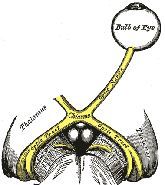
Home

Lab Tour

Lab Syllabus

Papers

Symposium
 Resources Resources
-
-
|
-

Lab 2: Stimulating Skeletal Muscle
[Reading] [Overview] [Useful Links] [Lab Report] [Further Study]
Pre-lab reading
- Lab manual - pages 17-28
- Vander, Sherman, and Luciano - Chapter 11, Section A: Skeletal Muscle.
- If someone in your lab group has a copy of a human anatomy textbook, bring it to lab this week to look up muscles you might want to stimulate.
Overview
Inhale. Sing a song. Walk to a café. Bite into a croissant. Dance all night. Run for the BART. All of these actions depend on skeletal muscles. The muscles may contract quickly, slowly, gently, or with great force. They may act for a brief instant or continue for hours. You may control them voluntarily or they may act reflexively without your even being aware of them. The next three labs will focus on how motor neurons control the activity of skeletal muscles to allow for a wide range of motions. In the first two labs, you will use a variety of techniques to determine how muscles respond to electrical stimuli, how fast motor neurons transmit information to muscles, and what patterns of electrical signals are received by a major locomotory muscle. In the third lab you will apply some or all of these techniques to other questions you choose about motor control and human activities.
In this lab, you will simulate the effect of motor neurons on muscles by applying controlled electrical stimuli to a muscle in your forearm. To measure the effect of the stimuli, you'll record the motion of a finger controlled by that muscle. The questions you will address in this investigation include:
- Do the properties of a single twitch vary with stimulus intensity?
- How does a muscle respond to changes in stimulus frequency?
- How does fatigue affect the contraction characteristics of a muscle?
To see pictures of the equipment and how it is used, visit the
lab tour page.
Useful Links
- Muscle Physiology web page (medical physiology course at U. of Vermont)
- BioRobotics Lab - researchers at U. Washington are developing a robotic human arm to study biomechanical and neural properties of real arms.
- Neuromuscular Research Center, Boston U. - Some good references to how motor unit function is studied.
- The Muscle Physiology Lab at UC San Diego has some useful references and a muscle physiology page with good explanations of how muscle architecture affects the strength and velocity of contraction and a reference to a study on the use of electrical stimulation of muscles for rehabilitation following surgery.
Lab Report
The lab report should include three sections corresponding to sections IV, V, and VI in the lab manual. In each section, describe briefly what trials you conducted and what results you found. You do not need to repeat the information found in the methods section of the lab manual, but be specific about which motor point you used and any other non-standard details. For each characteristic you measured (e.g. latent period), present the mean, standard deviation, and sample size. It is not necessary to present the raw data. Your verbal description of the results should include answers to all of the questions in that section of the lab manual. Additional content for each section includes:
Single Twitches and Recruitment. Include one image of a single twitch recorded in the Chart software.
Temporal Summation. Include one image of summation and/or tetanus recorded in the Chart software.
Fatigue. Use a t-test or ANOVA to determine whether any differences you see between rested and fatigued muscles are significant. Include the statistical tables from StatView for these analyses.
Further Study at Berkeley
Courses related to this lab topic
IB124. Musculoskeletal Biomechanics. The purpose of this course is to teach you how to analyze the musculoskeletal system in humans and other animals using the principles of physics and physiology.
IB121. Muscle Biology and Plasticity. The course provides a basic understanding of skeletal muscle structure and function. The changes of muscle during the processes of development and aging are discussed, as are the adaptations to physical activities characterized by different recruitment parameter and biomechanical loading characteristics, and to injury and regeneration. The importance of these topics to generate and sustain human movement is developed.
IB126. Neuromuscular Fatigue. Analysis of mechanisms of nerve and muscle excitation and muscle contraction, and changes occurring during fatigue and recovery.
IB127. Motor Control. We will develop a basic understanding of modern theories of information and control, then analyze neuromotor systems to understand the elements of motor control systems; muscles, sensory transducers and motor systems of the brain. We will use information and control theories to synthesize knowledge of the elements into understanding of the control systems that regulate posture, locomotion, and voluntary movement.
Faculty doing research related to this lab:
U. C. Berkeley
-
-
-
Last updated 1/13/06
- Copyright © Department of Integrative Biology. All rights reserved 2006
-
-
-
|
|